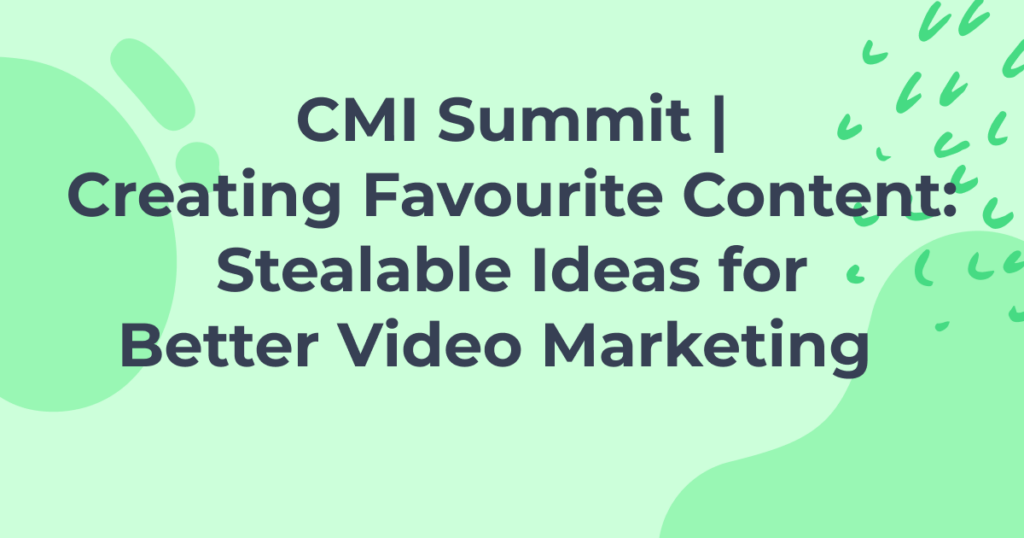Modern businesses have amassed huge libraries of video, from explainer content, to demos, how to videos, recorded webinars, promo videos; you name it, businesses have got it on camera. So much so that businesses now have, on average, 293 videos in their library, and that number is expected to double in the next 16 months. But whether you have five videos or 5,000 videos, your goal as a marketer should be to maximize the ROI and get as much value as you can from each video asset. Today in this Chalk Talk, I want to talk about how you can use a modern video marketing platform and your existing video library to reach new audiences, generate new leads, and ultimately accelerate your deal cycle and drive prospects to the buying cycle faster with video. First things first is getting more eyes on your video content.
Where to Start
I suggest starting with your website and making sure that all of your videos are optimized for SEO, include the right metadata, and make sure that your videos are in your sitemaps so that search engines like Google can find it. Google does index video as part of the search results and it presents a very visual and compelling call to action in an otherwise sea of search results.
Now you can look at using video on your blog. I would suggest getting started with an old webinar, including the full video of that webinar in your blog post, and writing a quick transcript of some of the key points. This is a great way of getting eyes on a piece of older video content and also getting a free blog post topic out of it, which, as a content marketer, I love.
I would also suggest including video in your email campaigns. The play button is one of the most compelling calls to action on the web, and that goes doubly so for email. Include culture content, old campaign videos, even short how-to videos in your nurture campaigns and you will see an increased engagement on that video content and in your email campaigns.
Next up is social and YouTube. I’m a big fan of using YouTube, but I think businesses make one big mistake when they’re setting up videos on their YouTube channel, and that is not including a link back to your website. If you don’t give people an opportunity to get back to where you want them to go, they’re just going to get lost in YouTube and you’re never going to see them again.
Last but not least is video hubs. This is a relatively new piece of technology. It allows you to create a private YouTube like experience on your website and you can group your videos into categories like how-to videos, customer testimonials, culture content, and give people the chance to consume your video content while seeing recommended videos that are only from your library.
Driving More Clicks on Your Video
So, once you have those more viewers, how do you increase the click-through rate on the videos that you already have? I suggest starting with the metadata, so title, description, and the keywords on your video. You’re going to want to make sure that this is consistent across all of the videos wherever they’ve been embedded. This is one of the nice things that a like a platform like Vidyard can do. If you change the title and description in one place, it’ll propagate that change everywhere so all of your videos are always up to date.
Next up, I would say, is making sure that your thumbnail is compelling. Your thumbnail is the thing that people see before they click play, and you want to make sure that you have a compelling one because like it or not, people do judge books by their covers. Many video platforms allow you to split test your thumbnail image so you can pit two or three different thumbnails against each other and find the one that is the most compelling. This is a great way of making sure that all of your videos are always optimized for click-throughs.
Turning Viewers Into Leads
Once people are clicking on your videos, then you want to make sure that they’re converting as a result of that video content. I suggest starting with a post-roll call to action, something like a subscribe button, sign up for more information, option to download whatever content asset you’re talking about, anything that gives people who have been engaged enough to watch that video all the way to the end the opportunity to do something about it.
You can also set up a choose your own path style video, where you present three or four videos at the end of a piece of video content, giving people a chance to continue consuming that video. YouTube does a great job of this by offering recommended content, but you can do the same thing with your own videos.
Last up is lead forms, and whether you use them pre-, during, or post-roll, they’re a powerful way of getting people to self select themselves as leads, and ultimately accelerate themselves a little bit further into that buyer’s journey all on their own. I’m a big fan of post-roll lead forms because as far as I’m concerned, again, same as the post-roll CTA, if somebody’s watched your video all the way to the end, that’s a pretty compelled lead. Give them the chance to put their hand up and say “I’d like more information” or “I’d like to sign up for a demo.”
Video for Sales
Last but not least is getting your video content used by sales. Sales people are interacting with prospects on a daily basis, and they are looking for content to send out. All you have to do is make sure that that content’s easy to access and works in a way that fits with their workflow.
First up is making sure that each one of your videos has an individual page that salespeople can send prospects to similar to what you get on YouTube when you link to an individual video. Now, a platform like Vidyard makes this very easy by giving a sharing page for every single player that you create, and why this is so powerful is that it gives your sales team the ability to just select a single video, send it out to a prospect without distractions and without anything else to click on. So rather than sending them to YouTube or to a landing page, all they’re sending them to is that video, and they know for sure whether or not they’ve watched it.
Another thing you’ll want to make sure of is that it’s easy for sales to share your video content via email or through their prospecting tool. Here’s how we do this with Vidyard: Within your email tool, you’ll see a Vidyard button you can click on and this will show a drop down of all the videos you have access to. You can click on one or many different videos and it will automatically drop a thumbnail of those videos into your email and send it off to prospects. Your sales team will see who’s clicked on which videos, how long they’ve watched, and be able to get other engagement data on the video content in addition to being able to very easily share your videos.
This is very, very powerful stuff, and everyone knows that sales teams are hungry to be able to provide the right content at the right time to prospects, so a little bit of effort in terms of getting your videos so that your sales team can share them easily will go a long way in making sure that those videos stay relevant to your prospects.
So, whether you have five videos or 5,000 videos, using these tips and a video marketing platform, you can breathe life into your existing video content to get more eyes on your videos, get those people better engaged with your video content, and hopefully ultimately accelerate your sales cycle and close more deals. My name is Jon Spenceley, and this has been a Vidyard Chalk Talk.


